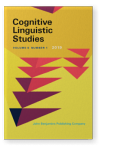Vol. 6:1 (2019) ► pp.58–83
Meaning hides in the confusion of the construction
The Characteristic-As-Place Construction
This study revisits constructionist (CxG) views concerning detailed and often unusual semantics of schematic constructions, especially those located toward the closed-class end of the lexicon-grammar continuum. The discussion is based mainly on a previously unstudied grammatical construction with interesting semantic properties, and it is shown that although clear semantic patterns can be observed in its most common uses, the construction is capable of expressing meanings that go beyond a preliminary characterization suggested by typical attestations. It is hypothesized that two kinds of meanings can be observed in grammatical constructions. One is the typically grammatical, relatively general meaning known to be conveyed by closed-class forms. The other includes highly detailed readings found in clearly productive patterns, which function within a construction; these relatively rich meanings are not necessarily the content of a construction. Based on uses of a number of constructions discussed here, it is suggested that many characterizations of the semantic content of schematic constructions proposed in the literature may be too detailed. The study concludes in proposing a correlation, under which the degree of specificity of a construction’s meaning depends on the amount of fixed lexical material found in it.
Article outline
- 1.Introduction
- 2.The Characteristic-As-Place Construction
- 2.1A form highlighting a salient characteristic
- 2.2The typical meaning of CAP
- 2.3Additional meanings
- 3.Two types of meaning
- 3.1The most frequent meanings do not come from the construction
- 3.2Sense patterns are not constructions
- 3.3Semantic compatibility in the service of creativity
- 3.4A case in point: Time-away construction
- 4.Meanings of constructions
- 4.1Closed-class and open-class forms
- 4.2Correlation between substantiveness and semantic content
- 5.Conclusions
- Acknowledgements
- Note
-
References
